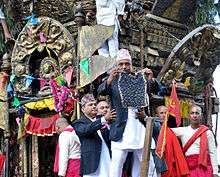Jawalakhel
| Jawalakhel | |
|---|---|
| Urban Subdivision | |
 Jawalakhel Location in Nepal | |
| Coordinates: 27°40′N 85°19′E / 27.667°N 85.317°ECoordinates: 27°40′N 85°19′E / 27.667°N 85.317°E | |
| Country | Nepal |
| Zone | Bagmati Zone |
| District | Lalitpur District |
| Time zone | Nepal Time (UTC+5:45) |
Jāwalākhel (Nepali: जावलाखेल) is a subdivision of Lalitpur in Nepal. It is located 2 km from the ancient city centre (Pātan). Lalitpur (Patan) was one of the three great capitals of Nepal until the 18th century.[1]
Origin of the name
Jawalakhel means "rice throwing field" in Nepal Bhasa. The name is derived from the large open field at the town's center where cooked rice is offered during an annual religious festival. The field is the venue of Bhoto Jātrā, the festival of the display of the sacred vest, which is the most important cultural event held in Jawalakhel.
Highlights

Bhoto Jatra is the grand finale of the chariot festival of Bunga Dyah, the longest street celebration held in Patan. During the chariot festival which lasts over a month, two towering cars containing images of the deities Bunga Dyah (Machhendranath) and Chākuwā Dyah (Minnāth) are pulled through the streets of Lalitpur in stages.[2]
The chariots are brought to Jawalakhel for the concluding ceremonies. During Bhoto Jatra, the holy garment "bhoto" is held up from the four sides of the chariot and shown to the enraptured throng that fills the large field.[3]
Jawalakhel is also famed as the home of Central Zoo, the only zoo in the country. It was built as a private menagerie by a Rana prime minister in 1932. The government took over the zoo after the dynasty was ousted, and opened it to the public in 1956.[4] In December 1995, the government handed over responsibility of running the zoo for 30 years to the National Trust for Nature Conservation.[5]
Jawalakhel is the cradle of Nepal's hand-woven woolen carpet industry. In 1960, the government of Nepal, the International Red Cross and the Swiss Aid for Technical Assistance worked together and set up a factory in Jawalakhel where Tibetan refugees could produce Tibetan handicraft to support themselves. The refugees used their hereditary skills and wove woolen carpets like the type traditionally made in Tibet, and an industry was born in Nepal.[6]
References
- ↑ Thomas, Michael; Cuhaj, George (2009). Standard Catalog of World Gold Coins. Krause Publications. p. 1062. ISBN 9781440204241.
- ↑ Vajracharya, Munindraratna (1998). "Karunamaya Jatra in Newar Buddhist Culture". Retrieved 16 February 2014.
- ↑ "Bhoto Jatra marked amid much fanfare". The Kathmandu Post. 16 February 2014. Retrieved 23 May 2013.
- ↑ "Welcome to Central Zoo". Central Zoo. Retrieved 16 February 2014.
- ↑ Central Zoo: The Only Zoo of Nepal
- ↑ Gurung, Tsering Dolker (10 June 2011). "The rise and fall of the Tibetan carpet industry". Nepali Times. Retrieved 17 February 2014.